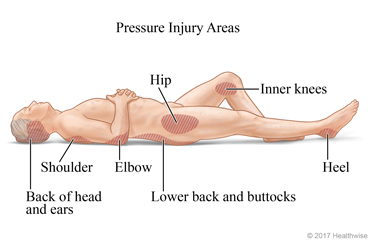
What are pressure injuries?
A pressure injury on the skin is caused by constant pressure to that area. The pressure damages the skin and underlying tissues, creating an injury. This can happen when you lie in bed or sit in a wheelchair for a long time.
Pressure injuries usually occur over bony areas, such as your sit bones, hips, lower back, elbows, heels, and shoulders. Pressure injuries can also occur in places where the skin folds over on itself, or where medical equipment presses on the skin, such as when oxygen tubes press on the ears or cheeks.
Pressure injuries can range from red areas on the surface of the skin to severe tissue damage that goes deep into muscle and bone. Severe injuries are hard to treat and slow to heal. When pressure injuries do not heal properly, problems such as bone, blood, and skin infections can develop.
What causes pressure injuries?
Pressure injuries are caused by constant pressure on the skin and tissues.
Other things that can make pressure injuries more likely include:
- Sliding down in a bed or chair (shear force).
- Being pulled across bed sheets or other surfaces (friction).
- Not getting enough nutrition to keep your body working well (malnutrition).
- Not being able to get out of bed or walk around (immobility).
- Having a disease that affects how well blood circulates in your body, such as diabetes or peripheral arterial disease.
- Excess moisture, such as from sweat, urine, or feces. Skin that is often wet is more likely to break down and form pressure injuries.
How can you help prevent pressure injuries?
Relieving and spreading out pressure is the most important part of both preventing and treating pressure injuries. Putting pressure on one spot for long periods of time damages the skin and underlying tissues. Pressure can be relieved and spread in several ways. Often a combination of these is best.
- Change position often.
- In a bed, change position every 2 hours. Learn how to move yourself so that you avoid folding and twisting your skin.
- In a wheelchair or other type of chair, shift your weight every 15 minutes.
- Try not to slide or slump across sheets in a chair or bed. Recliner chairs are likely to allow slipping, so don't sleep in a recliner. Try to keep the head of a bed, a recliner chair, or a reclining wheelchair raised no more than 30 degrees.
- Take good care of your skin.
- Bathe as often as needed to be clean and comfortable. Use gentle soap, and use warm (not hot) water. Be careful not to scrub the skin too hard.
- If you have problems with bowel or bladder control, clean your skin right away if it gets soiled or wet. Use a protective barrier cream, lotion, or ointment to protect your skin from wetness. Use pads or briefs that absorb moisture and pull it away from your skin.
- If you have dry skin, use moisturizing cream or lotion to keep your skin from drying out and cracking.
- Check your skin every day for signs of pressure injuries. Pay special attention to bony areas such as the hips, elbows, knees, and heels. Also watch for pressure from sources such as:
- Body parts or skin folds, especially if you're overweight.
- Chair arms, parts of wheelchairs, braces, or other places where you rest your elbows or other body parts.
- Medical equipment such as oxygen masks or oxygen tubing.
- Make healthy choices.
- Eat healthy foods with enough protein, and get plenty of fluids (unless your doctor has told you to limit your fluid intake). That can help damaged skin heal and help new skin grow.
- If you smoke, quit or cut back as much as you can. Talk to your doctor if you need help quitting. Smoking dries the skin and reduces blood supply to the skin.
- Talk to your doctor about pressure-relieving cushions and pads.
- Use special support surfaces. There are mattresses, bed covers, and chair cushions designed to help reduce and spread pressure.
- Ask your doctor which cushions and pads might help you. Some products, such as doughnut-type devices, may actually cause pressure injuries or make them worse.
If you or someone you care for is not able to move much, it's important to prevent pressure injuries and to check the skin every day. If you think that a pressure injury is forming, take steps to treat it. Talk to your doctor or nurse about what more you can do.
Where can you learn more?
Go to http://www.healthwise.net/patientEd
Enter H403 in the search box to learn more about "Learning About Preventing Pressure Injuries".
Current as of: December 4, 2024
Author: Ignite Healthwise, LLC Staff
Clinical Review Board
All Ignite Healthwise, LLC education is reviewed by a team that includes physicians, nurses, advanced practitioners, registered dieticians, and other healthcare professionals.

